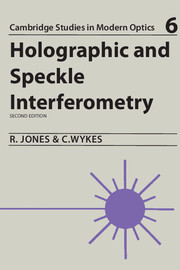Book contents
- Frontmatter
- Contents
- Preface to the first edition
- Preface to the second edition
- Acknowledgements
- 1 Basic optical principles
- 2 Holographic interferometry
- 3 Speckle pattern interferometry
- 4 Electronic Speckle Pattern Correlation Interferometry
- 5 Holographic and speckle pattern interferometry techniques for shape measurements
- 6 Experimental design and technique
- 7 Applications
- Appendices
- References
- Index
2 - Holographic interferometry
Published online by Cambridge University Press: 05 August 2012
- Frontmatter
- Contents
- Preface to the first edition
- Preface to the second edition
- Acknowledgements
- 1 Basic optical principles
- 2 Holographic interferometry
- 3 Speckle pattern interferometry
- 4 Electronic Speckle Pattern Correlation Interferometry
- 5 Holographic and speckle pattern interferometry techniques for shape measurements
- 6 Experimental design and technique
- 7 Applications
- Appendices
- References
- Index
Summary
Introduction: basic techniques and the general problem
It is the opinion of many scientists involved in the complex subject of surface deformation analysis that one of the most important techniques to emerge from the principle of holography (Section 1.7) is that of holographic interferometry. This enables the static and dynamic displacements of an optically rough surface to be measured interferometrically. First reports of the method appeared during the mid 1960s (for example, references 1–5) and were soon followed by numerous papers describing new general theories and applications (Section 2.9). One of the main reasons for such interest is that holographic interferometry clearly removes the most stringent limitation of classical interferometry (Section 1.5.5) i.e. that the object under investigation be optically smooth. Thus the advantages of interferometric measurement, for example, high sensitivity and non-contacting field view, can be extended to the investigation of numerous materials, components and systems previously outside the scope of optical study.
Let us first consider qualitatively how the holographic recording of a scattering surface can be used to detect the displacement of that surface. It has been shown in Section 1.7.3 that the developed hologram reconstructs a virtual image of the original object. If one views the precise superposition of the light from the reconstructed image and the real object through the hologram, then the interference of the two identical wavefronts results in a uniform field of view.
- Type
- Chapter
- Information
- Holographic and Speckle Interferometry , pp. 64 - 121Publisher: Cambridge University PressPrint publication year: 1989
- 4
- Cited by

